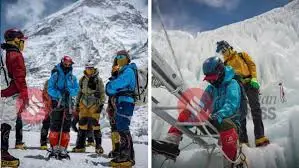Meet the first visually impaired Indian woman to scale Everest, from a village in Himachal Pradesh

A Mountain Dream Born in Darkness
Chhonzin Angmo lost her eyesight at the age of eight due to a severe reaction to medication. Where others might have retreated into silence or sorrow, Angmo’s spirit only grew stronger. She drew early inspiration from Helen Keller and carried a simple belief: “If we have the willpower, nothing can stop us.”
Despite the challenges of living with a disability in a remote Himalayan village, Angmo refused to let blindness define her limits. Her family, teachers, and a few kind mentors ensured she continued her education, eventually leading her to a job at Union Bank of India—a workplace that would later sponsor her dreams of mountaineering.
Training Against All Odds
Angmo’s path to Everest was neither smooth nor direct. Before even dreaming of the world’s tallest peak, she had to prove herself on smaller summits. She trained at high altitudes, tackled rigorous mountaineering courses, and participated in expeditions across Ladakh, including the challenging Siachen Glacier trek under Operation Blue Freedom in 2021—an initiative empowering people with disabilities through adventure sports.
Her dedication was unshakable. She practiced navigation using sound cues and adapted techniques, climbed with specialized gear, and relied on her team for constant communication. The physical demands of mountaineering were immense, but even tougher was fighting public perception—that a blind woman from a village had no place on the roof of the world.
The Everest Ascent
The 2025 Pioneer Everest Expedition was led by retired Lt. Col. Romil Barthwal, with expert Sherpas Dandu Sherpa and Om Gurung accompanying Angmo. Their trust in her capabilities was unwavering. After weeks of acclimatization, battling extreme cold, fierce winds, and the deadly “death zone” above 8,000 meters, Angmo reached the summit.
In that moment, she carried more than just the tricolor. She carried the hopes of every disabled person who had been told “you can’t.” She proved that strength lies not in sight, but in vision.
More Than Just a Climber
Angmo’s triumph is more than a personal milestone—it’s a national inspiration. Her name now stands alongside legends like Erik Weihenmayer (USA, 2001), Andy Holzer (Austria, 2017), Zhang Hong (China, 2021), and Lonnie Bedwell (USA, 2023)—all visually impaired mountaineers who dared to dream the impossible.
Back home, her story has galvanized not just the visually impaired community, but also women and youth in remote regions. From the narrow lanes of Chango to the global stage, Angmo’s journey is a masterclass in perseverance.
Recognitions and Future Goals
In 2024, she was honored with the National Award for the Empowerment of Persons with Disabilities under the ‘Sarvshresth Divyangjan’ category. Yet for Angmo, the Everest summit is just the beginning. She now plans to scale the highest peaks on every continent—an ambition known in mountaineering circles as the “Seven Summits.”
“I want to show the world that disability is not inability,” she says. “Mountains don’t discriminate, and neither should society.”
Legacy in the Making
Chhonzin Angmo’s story is not just about mountaineering. It’s about representation, resilience, and rewriting the rules of what is possible. In an age where achievements are often measured in social media likes, hers is a tale of quiet grit and unshakable purpose.
She climbed Everest without the privilege of sight—but with a vision that now lights the path for countless others.






